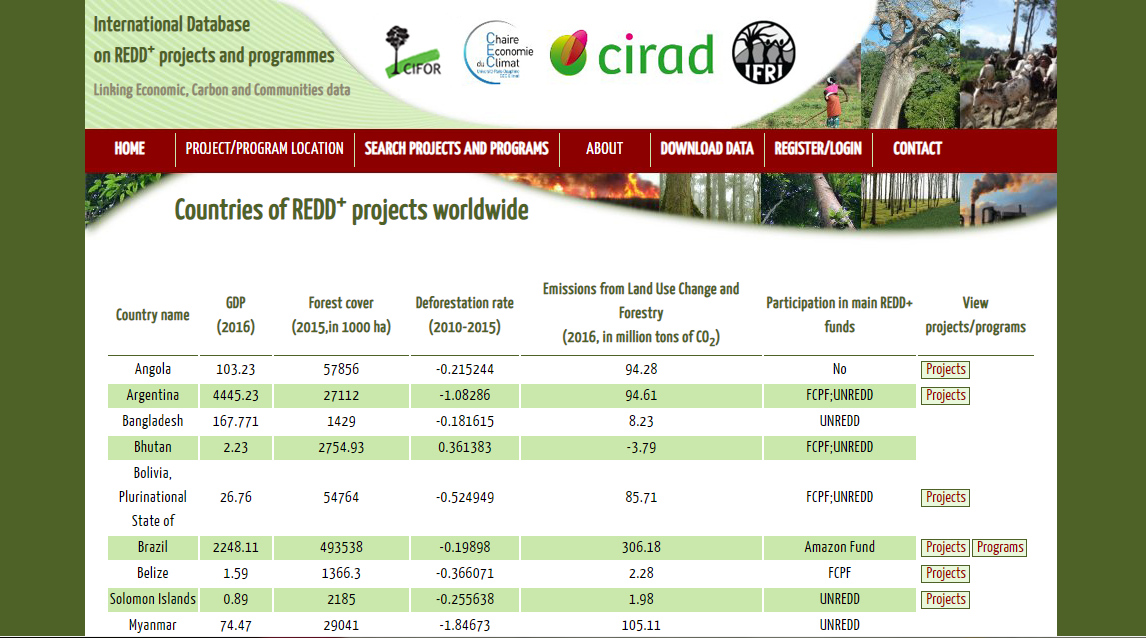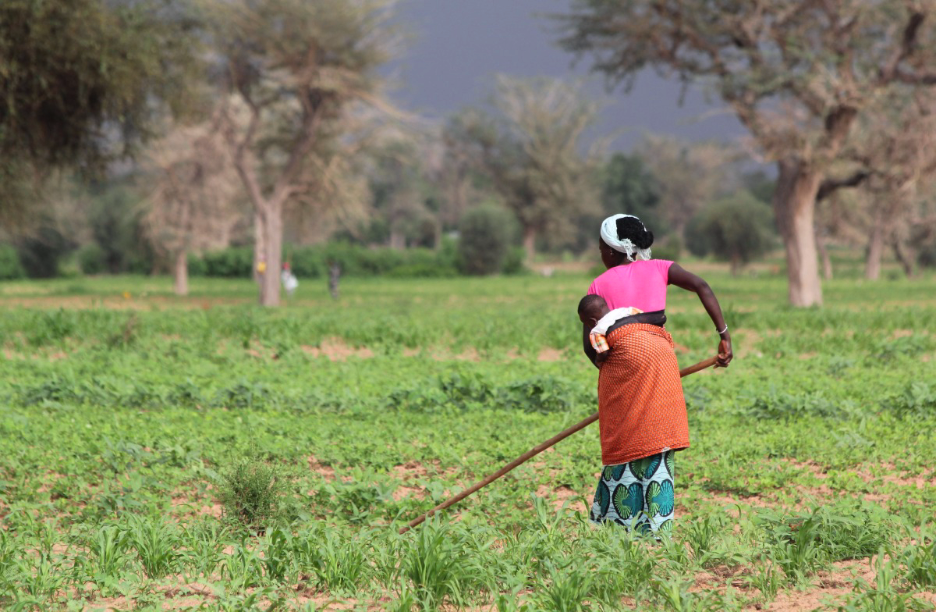- A searchable database of 467 forest carbon emissions reduction (REDD+) initiatives in 57 countries is now available through the Center for International Forestry Research (CIFOR).
- The ID-RECCO database gathers in one free online tool over 100 different categories of information – including project partners, activities, and funding sources – on these subnational projects aimed at conserving forests, promoting local economies, and reducing greenhouse gas emissions from deforestation and degradation.
- The tool makes these data and their sources accessible to anyone, with minimal interpretation: while it does not summarize project results, it provides goals, activities, and links to project websites for the reader to learn more.
A searchable database of initiatives to reduce greenhouse gas emissions from deforestation and forest degradation (REDD+) is now available through the Center for International Forestry Research (CIFOR).

Launched in 2015 by the French Agricultural Research Centre for International Development (CIRAD), the International Database on REDD+ projects and programs Linking Economic, Carbon and Communities data (ID-RECCO) contains 467 initiatives in 57 countries aimed at reducing greenhouse gas emissions from deforestation and forest degradation (REDD). Some also promote sustainable forest management and enhancement of forest carbon stocks (REDD+). Of these, 359 are considered currently active, 67 were completed before 2018, and 41 have not yet started or have been discontinued.
The free online ID-RECCO tool aims to help researchers, governments, and potential project leaders better understand REDD+ projects by centralizing data on as many projects as it can find data for, standardizing how the data for all these projects are organized, and presenting the information in a format that is easily adapted to research and analysis.
Using the database
The database is organized first by country, which you choose either in a list or on a map. Hovering your computer cursor over a country on the map displays the number of REDD+ projects the database contains for it. Clicking on the country produces a list of its projects with each project’s name, type, size, and current status, and a link for more details.

Users can view and download the data for free, though you must register to be able to download the data tables.
The website makes the data available for download in CSV file format, separated into tables organized by country, project name, project type, partners, among other filters.
Viewing the data in a spreadsheet program may require some reformatting. Copying and pasting the entire contents of each CSV file into a text editor, then copying and pasting it back into Excel or another spreadsheet program should produce a proper formatting, although formatting corrections may still be needed for some individual rows of data.

The database includes up to 110 variables—such as size, location, deforestation drivers, and expected socio-economic and environmental impacts—as well as a web link, for each project. For example:
- The projects table contains the objectives, locations, time periods, social and natural environments, activity types, and information sources for each project.
- The carbon credit table provides data on the quantity sold, the price, and the buyer for each project that sold carbon credits.
- The communities spending table describes the types of benefits or payments made to communities as compensation for not clearing forest. These include payments of cash for preserving forest or ecosystem services, micro-credit loans, employment, training, and payments for carbon credits.
- A financing sources table includes the institution and amount of funding provided to the project.
The tool is the first to assemble all this information on subnational REDD+ initiatives and make it accessible to anyone. It also supplies the sources of information used and a list of publications related to the data.
“ID-RECCO has so far been used mostly by researchers,” CIFOR researcher Gabriela Simonet told Mongabay. “For instance, it has been cited in 30 academic publications and has been used by CIFOR to test the representativeness of the REDD+ projects and programs included in its Global Comparative Study on REDD+.”

Much of the project data are publicly available information, presented as “relatively objective compilations of facts with minimal interpretation”. Many projects lack information and so could be fictitious or abandoned, say Simonet and colleague Coline Seyller in a publication, but were retained in the database in case their status changed or their limited information proved useful. The database does not summarize results of the projects’ activities, though it provides links to project websites for the reader to learn more or consult the implementing institution. In their paper, the scientists recognize the potential biases and data quality issues inherent in publicly available project information without field visits to verify each project.
Emissions from loss of tropical forest
Degradation and deforestation of the world’s tropical forests together produce about 10 percent of net global carbon emissions; though estimates vary, these emissions are substantial. Institutions have agreed that the global effort to combat climate change must include steps to reduce the destruction of tropical forests.
REDD+ initiatives aim to help reduce climate change impacts, alleviate poverty, and sustain biodiversity and ecosystem services in forest-rich developing countries by:
- reducing emissions from deforestation and forest degradation;
- conserving and enhancing forest carbon stocks; and
- sustainably managing forests.
The Coalition for Rainforest Nations presented the concept of paying developing countries to reduce greenhouse gas emissions associated with deforestation at the Conference Of Parties (COP-11) of the United Nations Framework Convention on Climate Change (UNFCCC) in 2005. The proposed mechanism encourages countries to protect their forests by offering them credits for maintaining the carbon stored in forests (mainly trees and soil), as well as financial incentives, including access to carbon markets to sell those credits. The goal was to make the value of carbon in standing forests greater than that of the timber that required trees to be cut down.

It initially was intended to work at a national scale to prevent deforestation from just moving from one property to another (leakage). However, government and private sources have since supported numerous subnational and local-scale REDD+ projects globally. Simonet and colleagues created the ID-RECCO database to gather information from all these projects in one place.
Simonet echoed the findings of a recent study that found that the diversity of REDD+ projects and the scarcity of robust research about their ecological, social, or economic impacts has made it difficult to assess their effectiveness.
“In fact,” she said, “there have been very few studies that rigorously analyze the impacts of REDD+ projects on forests, although the few on carbon/land use outcomes show moderately encouraging results.” [see citations below]
Simonet created ID-RECCO while still a researcher at CIRAD, and the project has remained a collaboration of four institutions: CIFOR (Bogor, Indonesia), the Climate Economics Chair (Paris-Dauphine university, France), CIRAD (Montpellier, France), and the International Forestry Resources and Institutions (IFRI, University of Michigan, U.S.). She and her colleagues anticipate that assembling previously disparate data will encourage analysis and comparisons of the variety of REDD+ projects.

“It allows, for example, [users] to extract simple statistics, like the number of hectares covered by REDD+, said Driss Ezzine-de-Blas, a CIRAD researcher, in a statement, “and [to] understand the trends and types of REDD+ projects and initiatives.”
“Being frequently updated and open access, [ID-RECCO] constitutes a unique tool that makes possible monitoring and impact evaluation of those initiatives,” said Philippe Delacote, a researcher at Climate Economics Chair, in the statement, “which will provide a better understanding of the conditions of success of REDD+ implementation.”
Next steps in a new home
The project team is making two major improvements to the database now that it is hosted at CIFOR.
“First,” Simonet said, “the project-level information will be updated by December 2018 through an ongoing CIFOR survey to REDD+ project implementers (aimed at having the data checked by them, to increase data quality). Secondly, we are now distinguishing between local REDD+ projects and subnational jurisdictional REDD+ programs, and will be updating the information on [broader-scale] REDD+ programs based on a collaborative study being undertaken in collaboration with Earth Innovation Institute and the Governors’ Forests and Climate Task Force.”
With REDD+ initiatives seeking multiple overlapping benefits – including carbon emissions reductions, biodiversity protection, and rural development – project leaders, funders, and governments need more reliable evidence of where REDD+ projects succeed or fail to guide their project planning and implementation.
Citations
Simonet G., Agrawal A., Bénédet F., Cromberg M., de Perthuis C., Haggard D., Jansen N., Karsenty A., Liang W., Newton P., Sales A-M, Schaap B., Seyller C., Vaillant G., (2018) ID-RECCO, International Database on REDD+ projects and programs, linking Economic, Carbon and Communities data. version 3.0. http://www.reddprojectsdatabase.org
Bos, A. B., Duchelle, A. E., Angelsen, A., Avitabile, V., De Sy, V., Herold, M., … & Wunder, S. (2017). Comparing methods for assessing the effectiveness of subnational REDD+ initiatives. Environmental Research Letters, 12(7), 074007.
Duchelle, A. E., Simonet, G., Sunderlin, W. D., & Wunder, S. (2018). What is REDD+ achieving on the ground?. Current Opinion in Environmental Sustainability, 32, 134-140.
Simonet, G., & Seyller, C. (2015). ID-RECCO, a New Collaborative Work Tool to Improve Knowledge on REDD+ Projects (No. 2015-08). Climate Economics Chair Working Paper.
Simonet, G., Subervie, J., Ezzine-de-Blas, D., Cromberg, M., & Duchelle, A. E. (2018). Effectiveness of a REDD+ Project in Reducing Deforestation in the Brazilian Amazon. American Journal of Agricultural Economics.
The banner image by Rhett A. Butler/Mongabay shows a rainforest stream in Ujung Kulon, Indonesia.
FEEDBACK: Use this form to send a message to the editor of this post. If you want to post a public comment, you can do that at the bottom of the page.














